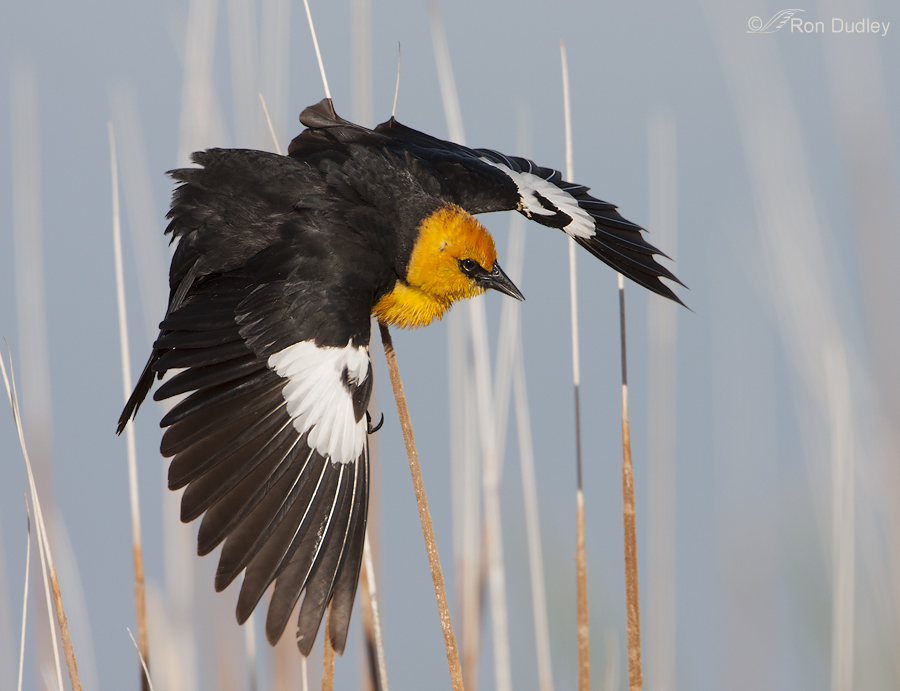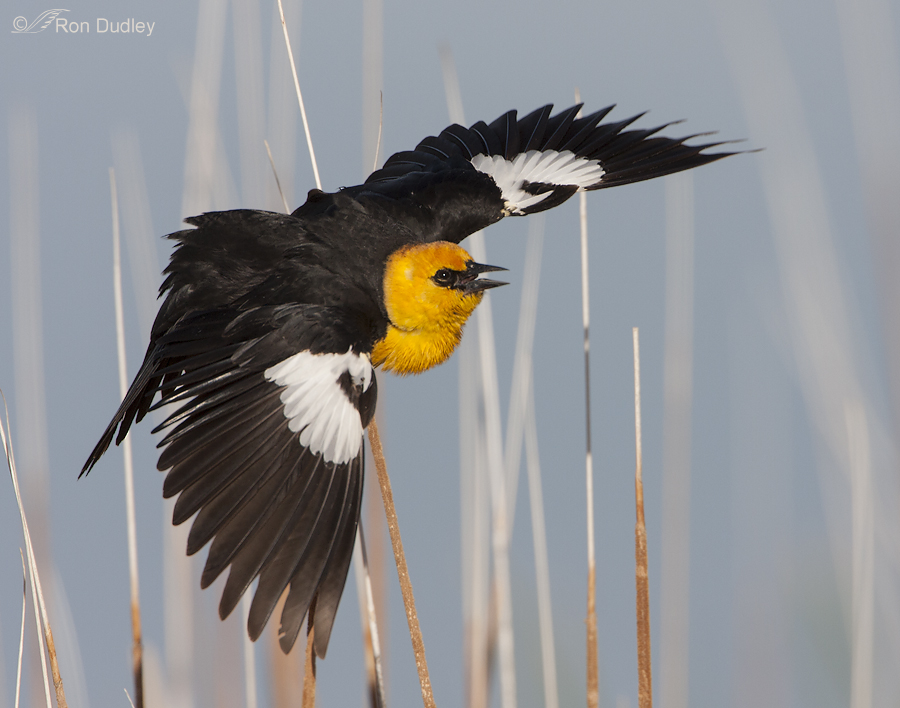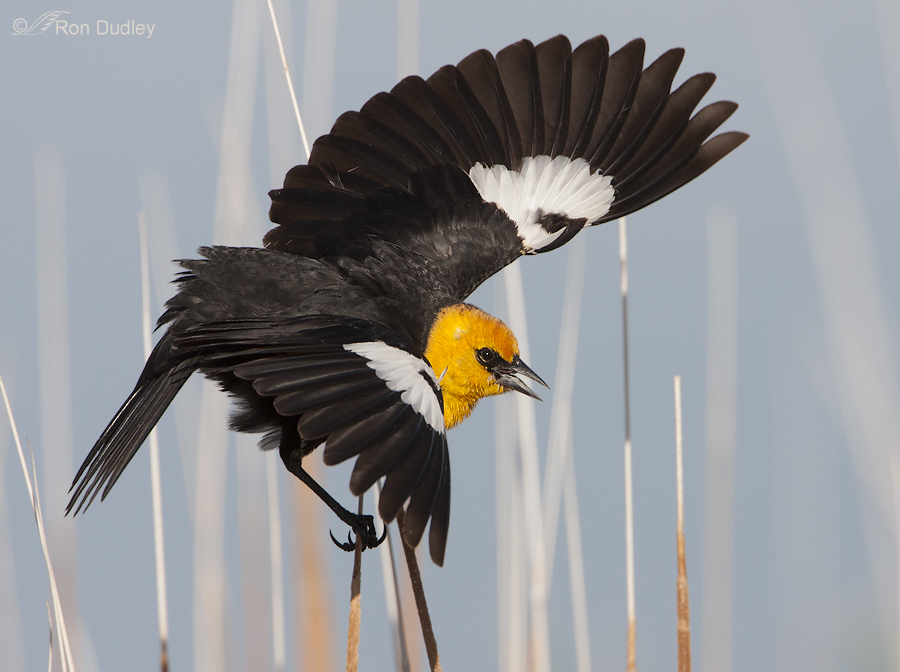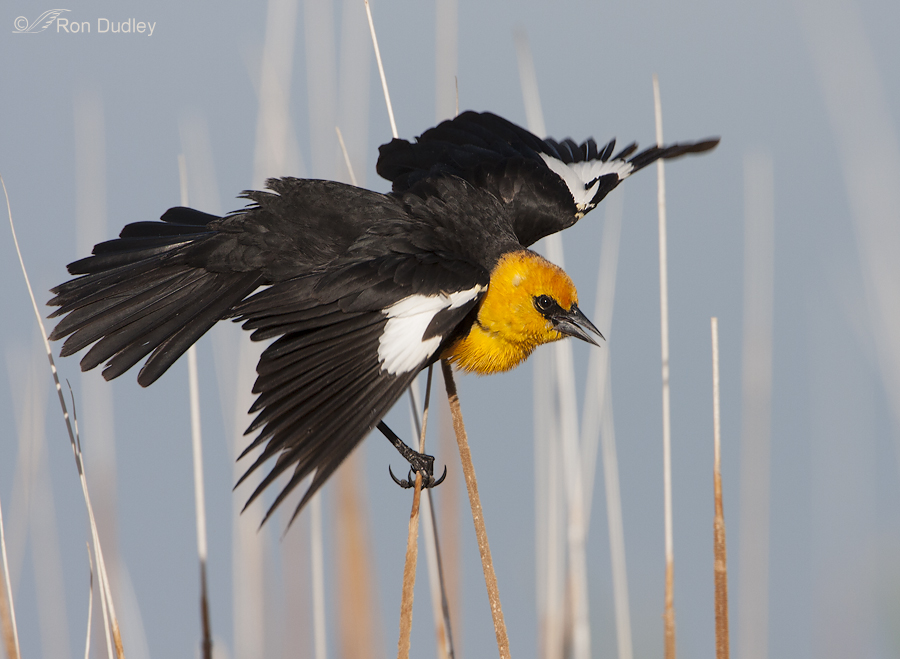Welcome to the month of March everyone – for me a psychological barrier between the depths of winter and the promise of spring. It’s supposed to be almost 50 degrees today and that has me thinking of spring birds, warmer temperatures, liquid water and some actual greens in the landscape.
By the Ides of March (only two weeks from now) male Yellow-headed Blackbirds will begin arriving in Utah and the females a week or two later. Almost immediately the males will begin their raucous calling as they compete for territories and later for females.
This male was defending breeding territory in May. Males display two primary types of song spreads – the Symmetrical Song Spread and the Asymmetrical Song Spread. Each song spread is accompanied by a distinct song type. Here’s a link to one of them.
In this sequence of images the male is displaying the Symmetrical Sound Spread where the bird spreads its wings to expose the white patches and the tail is lowered and spread. During this display he localizes with the song called the Accenting Song.
Once a display begins it almost seems like the bird loses voluntary control of its actions and the display must be completed before it regains control (my unscientific observation).
During part of this display the head is directed upward at 30-45 degrees.
This behavior is often difficult for the bird to complete without losing its balance on the typically spindly perches they prefer. The whole thing is quite entertaining to watch.
In this last shot in the series the display is just about complete.
The Symmetrical Song Spread is usually performed in response to other males flying over their territory or at the arrival of a new female.
Ron








Beautiful!Beautiful!Beautiful!
Oh the content coupled with the striking images! Tells a story. Impressed once again Ron. I love the first image where the bird shows an obviously distended OEC, getting ready to belt I assume! Blackbirds of all varieties are one of my favorite vocalists, even if they can sound a bit harsh.
What an astonishingly vivid bird. With a less than melodious call. I loved him though – thank you so much.
“less than melodious” is a generous description of their call, Elephant’s Child. Their “song” (in combination with their gyrations) is actually quite humerous.
Ron, we are oddly in sync. 🙂 Maria told me about this post … after I posted my post. It’s not possible to think of spring without these birds. Such lovely shots … illustrative, perfectly, of the display.
Being in sync with you has got to be a good thing, Ingrid. I’ll check out your post later this morning – I’m looking forward to it.
His song is similar but not the same as the Red-winged Blackbird’s, which I saw in FL. These birds remind me of my totally ignoring The Red-winged Blackbird in favour of the Great Blue Heron, when I was in FL. The Red-winged Blackbird was the “king” in Eustis Lake last April, and always had that loud song in the marshes, similar to the one you linked me with. I hope to catch up with him sometime again.
Sometimes one just has to choose a subject and go with it, Maria. I’ve done the same thing…
Maria, so funny! I grew up with red-wing blackbirds, and always thought they had the most beautiful song! 🙂
Bravo Ron, this is exquisite…They are all so perfect. You have taken advantage of the balancing act.
This could also be courtship display, right?
I doubt it, Maria. It was too late in the season (5/20) and he seemed to be responding to other males flying over his territory.
What a beautiful (and well fed…) bird with a, um, an interesting song/call. Must wake you up pretty suddenly if they sing in the early dawn hours. I never even heard of these, and you’ve given us a real treat with this display sequence. Love the brilliant golden yellow!
Breathtaking as usual! Thanks for taking the time…
I enjoy your photos very much, as well as the information you provide along with them. Case in point – the link to the audio of the Yellow-headed Blackbird. The audio give an additional dimension to your post.
Thanks
GAP
What wonderful shots! I have never seen one of these!